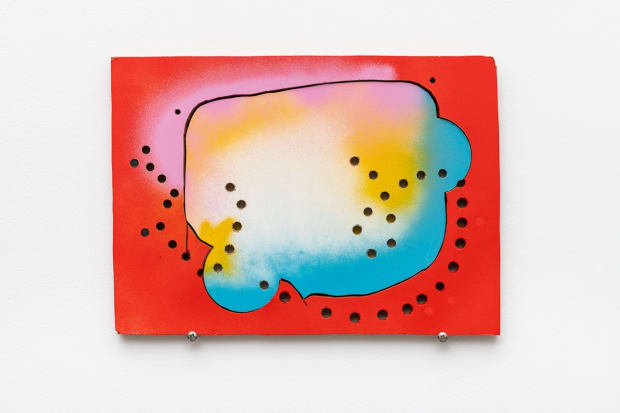-
Anderson Borba and Alexandre Canonico
12 April - 8 May 2021 -
-
Kupfer is pleased to present a duo exhibition featuring London-based artists Anderson Borba and Alexandre Canonico.
Bringing together a series of wall reliefs by Canonico and freestanding sculptures by Borba, the show has been conceived as a conversation between two artistic practices that make use of similar raw materials and procedures. In both cases, there is a strong sense of physicality and a keen interest in how materials behave and interact. Stylistically, the works are sometimes reminiscent of post-Minimalist or colour field abstraction (in the case of Canonico) and early 20th century sculpture or three-dimensional works by Brazilian self-taught artists such as Zé Bezerra or the figurehead carvers of the Lower São Francisco River (in Borba’s case). Borba and Canonico are, of course, artists of their own time. Even if these works occasionally carry indicial traits of an art historical lexicon of forms, they are ultimately concerned with issues of the present. From a material perspective, both artists employ cheap, industrial-grade wood commonly found in DYI stores, manipulating this material through the use of methods and gestures that are also characteristic of a DIY universe.
-
-
The starting point for Canonico’s wall pieces is the selection of unusually-shaped wooden off-cuts which he collects in his studio. Therefore, they initially emerge from a process that has been previously carried out in the making of other works. Leftover wood prompts new compositions in which oddly-shaped scraps are interlocked into a board like jigsaw pieces. Importantly, the interaction between the different parts is determined by what is possible to achieve with specific tools. For example, the straight line that runs vertically from the bottom edge in Glow Hole (2020) traces the path of a band saw across the plywood board - a necessary step that allows the saw to be moved in different directions to create the oval shapes in the centre of the composition. There is a self-explanatory frankness in Canonico’s works insofar as the gestures behind their making are left exposed in a blatant rejection of any type of illusionism or deceptiveness, a characteristic that can be loosely described as a kind of visual rendition of Richard Serra’s Verblist (1967-8).
And yet, despite their inherent candour, these wall reliefs are highly ambiguous: ‘neither sculpture nor painting nor drawing, neither two or three dimensional, but a vivid and always changing combination of all of the above’, to borrow a sentence used by Madeleine Grynsztejn to describe Richard Tuttle’s work. The numerous holes on the surface of the small scale works included in this exhibition, which in previous works played a purely functional role - i.e. to make room to insert a jigsaw blade into the board - are used here to create drawings; the holes featuring more prominently as compositional elements and at the same time emphasising the thing-like quality of the pieces. These drawings are further complemented by lines that emerge from the narrow empty spaces in between each interlocked block of wood, adding another essentially three-dimensional element whose status constantly oscillates between representation (a line on a plane) and the thing itself (the block-object).
-

-
-
-
-
-
While sharing some ideas around materiality, workmanship and language, Anderson Borba and Alexandre Canonico make work that has very different intentions and outcomes. Above all, we can say that both artists make work by thinking through materials - in this particular case using the same ordinary material -, incorporating ideas from different artistic legacies to expand the possibilities of sculpture in the present.
-
-
 Alexandre Canonico, Glow Hole, 2020 Sold
Alexandre Canonico, Glow Hole, 2020 Sold -
 Alexandre Canonico, Bang Bang, 2020 Sold
Alexandre Canonico, Bang Bang, 2020 Sold -
 Alexandre Canonico, Fountain, 2020 Sold
Alexandre Canonico, Fountain, 2020 Sold -
 Alexandre Canonico, Nesting, 2020 Sold
Alexandre Canonico, Nesting, 2020 Sold
-
-
Anderson Borba (Santos, 1972. Lives and works in London) completed the Alternative MFA program at The School of the Damned (2018) and is currently enrolled at the MFA Sculpture at Slade London (2019 - 2021). His work has recently featured in exhibitions at Set Gallery, Off Shoot Gallery and Assembly Point Gallery (London, 2019). He is the recipient of the Herbert Seaborn Memorial Scholarship Prize at Slade (2020) and the Gilbert Bayes Scholarship (2020).
Alexandre Canonico (Pirassununga, 1974. Lives and works in London) is currently completing the Postgraduate Programme at the Royal Academy of Arts (2017-21). Recent solo exhibitions include ‘Buraco’, at Galeria Marília Razuk, São Paulo (2019) and ‘Standstill’ at Kubik Gallery, Oporto (2019). Forthcoming shows include New Contemporaries, South London Gallery (2021).











![Anderson Borba, Shut up! [cords], 2021](https://artlogic-res.cloudinary.com/w_600,c_limit,f_auto,fl_lossy,q_auto/artlogicstorage/kupfer/images/view/d2e02f12cb1e822c9a785bb40f4658f2j/kupfer-anderson-borba-shut-up-cords-2021.jpg)
![Anderson Borba, Beastmode [Jacaré], 2021](https://artlogic-res.cloudinary.com/w_600,c_limit,f_auto,fl_lossy,q_auto/artlogicstorage/kupfer/images/view/a853c2eb5d0082995a3dc7ea61f10f17j/kupfer-anderson-borba-beastmode-jacar-2021.jpg)


